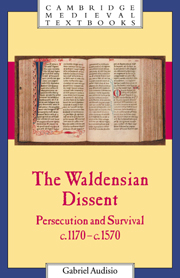Book contents
- Frontmatter
- Contents
- List of maps
- Preface
- Acknowledgements
- Introduction
- 1 1170 – 1215: decisive and purposive origins
- 2 The thirteenth century: the need to adapt
- 3 The fourteenth century: the challenge of believing differently
- 4 The fifteenth century: the risks of longevity
- 5 The constraints of a life in hiding
- 6 The need to organise
- 7 A culture of their own: the written and the spoken word
- 8 The sixteenth century: the end as a way forward?
- 9 Epilogue: the Waldensian Church
- Conclusion
- Bibilography
- Index
- Cambridge Medieval Textbooks
Conclusion
Published online by Cambridge University Press: 05 June 2012
- Frontmatter
- Contents
- List of maps
- Preface
- Acknowledgements
- Introduction
- 1 1170 – 1215: decisive and purposive origins
- 2 The thirteenth century: the need to adapt
- 3 The fourteenth century: the challenge of believing differently
- 4 The fifteenth century: the risks of longevity
- 5 The constraints of a life in hiding
- 6 The need to organise
- 7 A culture of their own: the written and the spoken word
- 8 The sixteenth century: the end as a way forward?
- 9 Epilogue: the Waldensian Church
- Conclusion
- Bibilography
- Index
- Cambridge Medieval Textbooks
Summary
Discounting the epilogue which, for reasons I explained above, is not a direct continuation of the preceding chapters, this work has aimed above all to write a history which means, among other things, to surprise. It was never inevitable, predetermined or fated that the Waldensian movement should emerge, or be excluded by the Roman Church, or survive and expand, or again dissolve into the Reformation. To be astonished by past events and so to attempt to understand and explain them is the art, and the secret, of the historian. As far as possible, we have tried to trace the history of a minority, step by step. We have pinpointed in the community of the Poor of Lyons behavioural characteristics directly linked to their minority status. In stark contrast with their early missionary spirit, they came to keep themselves to themselves as evidenced by their endogamous, or homogamous, marriages where documents have survived to this effect. A warm sense of solidarity developed, as a limited number of people shared a universal message. They were self-assuredly aware that they alone had access to the truth, to the point that a real superiority complex developed as their minority status became the sign, the proof and the guarantee of the truth they held. They were a dissent; they were also a religious minority. They were defending the path to salvation on a doctrinal and a moral level. Their challenge was of consequence, particularly in a society where everything was religious and religion was everything.
- Type
- Chapter
- Information
- The Waldensian DissentPersecution and Survival, c.1170–c.1570, pp. 215 - 224Publisher: Cambridge University PressPrint publication year: 1999



